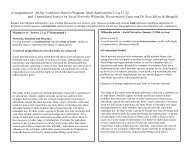Strange Scholarship in the Wegman Report - Get a Free Blog
Strange Scholarship in the Wegman Report - Get a Free Blog
Strange Scholarship in the Wegman Report - Get a Free Blog
You also want an ePaper? Increase the reach of your titles
YUMPU automatically turns print PDFs into web optimized ePapers that Google loves.
<strong>Strange</strong> <strong>Scholarship</strong> <strong>in</strong> <strong>the</strong> <strong>Wegman</strong> <strong>Report</strong> V1.0 09/26/10<br />
Advice on read<strong>in</strong>g this report<br />
Contradictions are found among WR, related testimony and later efforts,<br />
not so obvious when just read<strong>in</strong>g one part. The reader will f<strong>in</strong>d some<br />
redundancy of description as a result, as when repeat<strong>in</strong>g quotations for<br />
local read<strong>in</strong>g flow. The complexity of <strong>the</strong> WR and surround<strong>in</strong>g events<br />
often defies easy simplification, as comprehensive backup evidence must<br />
be <strong>in</strong>cluded. Common properties are given terse cod<strong>in</strong>gs, and numerous<br />
cross-references <strong>in</strong>cluded. I‘d suggest ignor<strong>in</strong>g all this on first read.<br />
This report largely expands on parts of an earlier one:<br />
#[MAS2010] John R. Mashey, ―Crescendo to Climategate Cacophony‖<br />
www.desmogblog.com/crescendo-climategate-cacophony<br />
V1.0 03/15/10.<br />
Many of <strong>the</strong> people, organizations and activities mentioned briefly here are<br />
described <strong>in</strong> detail <strong>the</strong>re.<br />
Similar typographic conventions are used <strong>in</strong> <strong>the</strong> ma<strong>in</strong> body here - Italics<br />
for op<strong>in</strong>ion and embolden<strong>in</strong>g or underl<strong>in</strong><strong>in</strong>g <strong>in</strong>side quotes m<strong>in</strong>e. Layout<br />
tries to balance convenience between paper-only and on-l<strong>in</strong>e readers. The<br />
latter might pr<strong>in</strong>t <strong>the</strong> ma<strong>in</strong> navigational aids (pp.2, 7, 8), <strong>the</strong>n open a 2 nd<br />
on-l<strong>in</strong>e copy of <strong>the</strong> PDF for jumps among Appendices. People who want<br />
to dig deep might also pr<strong>in</strong>t p.12 as a reference sheet for <strong>the</strong> many codes.<br />
Citations and references 2<br />
Citations found <strong>in</strong> <strong>the</strong> WR use its style, <strong>in</strong> which key MBH and MM papers<br />
have short codes, and all o<strong>the</strong>rs use Author (year). All 80 WR references<br />
are listed <strong>in</strong> W.8.2, although some are vague or do not actually exist.<br />
W.8.8 and W.8.9 comment on ~50 of <strong>the</strong>m, listed <strong>in</strong> <strong>the</strong> Index.<br />
This report‘s own citations mostly use <strong>in</strong>-l<strong>in</strong>e URLs for on-l<strong>in</strong>e<br />
convenience. Some references are listed <strong>in</strong> this report‘s own Bibliography<br />
and cited <strong>in</strong> <strong>the</strong> form [MAS2010]. Wikipedia is helpful for quick topic<br />
<strong>in</strong>troductions, but is never considered authoritative. For brevity, titles and<br />
given names are usually omitted, no discourtesy <strong>in</strong>tended to any.<br />
2 As per Wikipedia, en.wikipedia.org/wiki/Citation, ―More precisely, a citation is<br />
an abbreviated alphanumeric expression (e.g. [Newell84]) embedded <strong>in</strong> <strong>the</strong> body<br />
of an <strong>in</strong>tellectual work that denotes an entry <strong>in</strong> <strong>the</strong> bibliographic references section<br />
of <strong>the</strong> work‖ In-l<strong>in</strong>e URLs comb<strong>in</strong>e citation+reference.<br />
6<br />
This report has 4 major parts:<br />
Front matter – 12 pages<br />
This <strong>in</strong>cludes <strong>the</strong> usual Table of Contents, Glossary and a brief Index<br />
placed near o<strong>the</strong>r navigational aids. It also <strong>in</strong>cludes some unfamiliar<br />
elements used to classify patterns and problems.<br />
Memes are common climate anti-science messages, repeated so often that<br />
many are well-cataloged and numbered elsewhere. Here, a Theme is an<br />
important, generally accepted scientific idea or practice often ignored by<br />
<strong>the</strong> <strong>Wegman</strong> <strong>Report</strong>. The reader will often see text tagged with <strong>the</strong>se, like<br />
Meme-18❶ , or Theme-A❹,. O<strong>the</strong>r codes <strong>in</strong>clude for Errors, <br />
for Mean<strong>in</strong>g Changes, and for Biases, capitals rated more important.<br />
Any of <strong>the</strong>se are problems, but on first read, I would suggest ignor<strong>in</strong>g<br />
all this, except to notice how pervasive <strong>the</strong>y are. Some tables summarize<br />
<strong>the</strong>se. The few readers who want to dig deeply can follow <strong>the</strong> codes..<br />
F<strong>in</strong>ally, <strong>the</strong> Color codes evolved late as a way to simplify categories of<br />
Memes&Themes, References, People and Organizations.<br />
Likewise, I would suggest ignor<strong>in</strong>g <strong>the</strong> colors, except to know<br />
� Red usually means active climate anti-science, almost always a problem.<br />
� Orange and green have various <strong>in</strong>termediate mean<strong>in</strong>gs.<br />
� Blue usually means reasonable science or people (OK), often attacked,<br />
mis-used, or used as façade material (not OK). Theme ❹,.is always bad.<br />
Ma<strong>in</strong> discussion - §1 - §5 - about 25 pages.<br />
People familiar with <strong>the</strong> hockey stick wars can skip §1. The rest<br />
summarizes <strong>the</strong> W.* sections, <strong>the</strong>n puts all <strong>the</strong> pieces toge<strong>the</strong>r.<br />
A.* Appendices - about 70 pages.<br />
This collects various topics as backup for <strong>the</strong> ma<strong>in</strong> discussion. Few people<br />
would read more than a few, but choices will differ. The Appendices<br />
effectively form a 200+-page reference manual, also cover<strong>in</strong>g topics<br />
related to <strong>the</strong> <strong>Wegman</strong> <strong>Report</strong>.<br />
W.* Annotated <strong>Wegman</strong>, derivatives - about 135 pages.<br />
Each W.n Appendix corresponds to WR§n , <strong>in</strong> some cases summariz<strong>in</strong>g, <strong>in</strong><br />
o<strong>the</strong>r cases annotat<strong>in</strong>g whole sections, as <strong>in</strong> <strong>the</strong> plagiarism studies.



